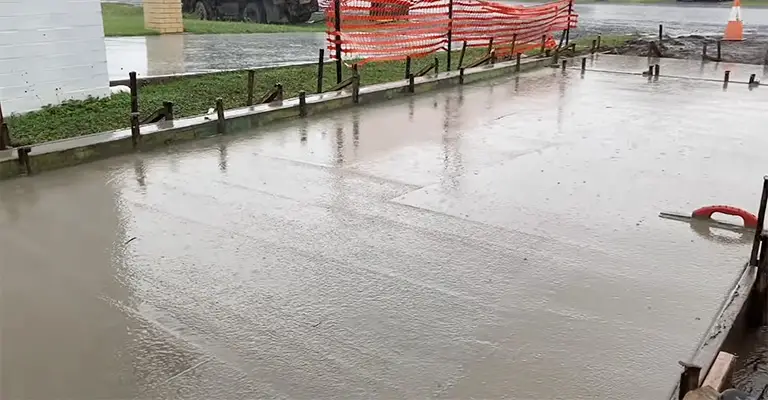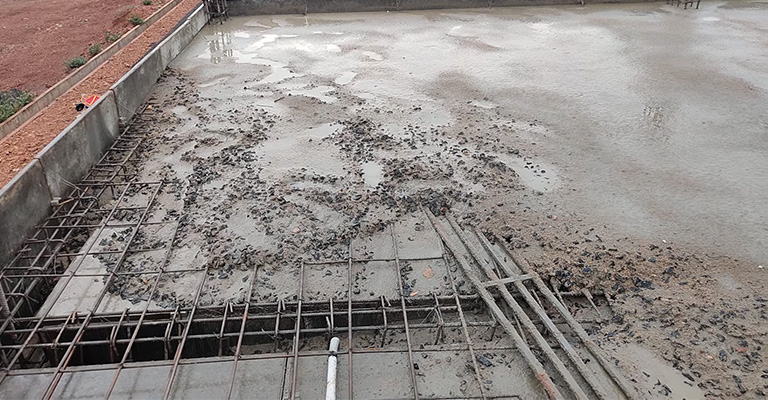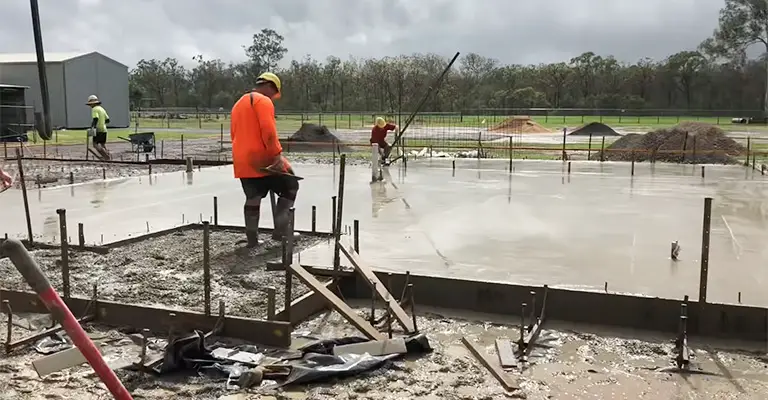Concrete is a versatile and durable material widely used in construction projects worldwide. It has the ability to withstand immense pressure and provide a strong foundation for buildings, roads, and other structures.
However, one common question that often arises is whether it’s possible to pour concrete after heavy rainfall. It’s a valid concern since water and wet conditions can potentially compromise the quality and strength of the concrete.
You can usually get away with a little bit of water, so it really depends on how much you are talking about.
It is a good idea to wait until the rain has passed before pouring concrete, then push or pull any surface water off the slab surface before finishing.
Rain is detrimental to concrete’s structural integrity, negatively impacting your projects and business.
It does not mean you’re off work for the day. There is no problem with pouring concrete in the rain. It is discouraged to pour concrete in the rain; however, sometimes, it is inevitable, so here is a guide to help you.
Do’s And Don’ts Of Pouring Concrete In The Rain
- When pouring concrete in the rain, ensure it is not essential.
- You should not mix rainwater into the concrete mix during curing; this will cause contamination.
- In case of rain after pouring concrete, cover the area.
- It is an excellent idea to check the weather forecast beforehand and be prepared for any surprises.
How Is Concrete Affected By Rain?

Keeping concrete moist after it’s laid is a great idea to help it cure, but extra water shouldn’t be added when it’s being mixed.
By changing the proportions of its various ingredients, rain can have a negative effect on concrete’s consistency.
As cement, aggregates and water are mixed in varying proportions, concrete is formed. Hydration, a chemical reaction between cement and water, is what makes concrete more robust and harder.
Rain or wet surfaces or trenches will affect the concrete mix, resulting in weak concrete when too much falls into it. Freshly poured concrete can become bumpy and uneven due to rain falling on it.
Although pouring concrete in the rain is certainly possible, it is essential to understand some of the potential problems that may arise.
Not Preparing For The Rain
If you pour cement in the rain, one of the biggest mistakes you can make is not preparing for the rain. As a result, you may have to scramble to dry the concrete to ensure it doesn’t wash away.
There is no point in putting concrete out before the rain if it hasn’t been given enough time to set.
Weak Top Layer Of Concrete
The top layer of concrete will become weak if water pools on top before it dries thoroughly. This top layer must be strong if you want to prevent chipping or peeling over time.
Although concrete will chip in some circumstances either way, if the top layers are weak, they will basically peel off.
Pouring concrete in the rain and avoiding concrete problems depends on preparing for possible rain.
Too Much Moisture In Concrete
Water is one of those crucial ingredients in concrete, one of the ingredients that is already mixed in with it.
If the concrete isn’t mixed precisely right, the concrete won’t turn out the way it’s supposed to, and it may even mean that the whole job will be a failure.
How Long After Rain Can I Pour Concrete?

You shouldn’t be concerned about rain if it’s forecast for the days or hours after you expect to finish the job. Rainwater won’t damage the concrete nearly as much as it might if the concrete is given four to eight hours to set up after mixing and finishing.
Some concrete mixes could benefit from rainwater on the surface as it aids the hydration and curing process. After 4 to 8 hours, however, you won’t notice any change.
Caution:
As a result, rainwater can sometimes be displaced by the concrete mixture, with the development that it can pool in the cavity as a result.
The rainwater should not be soaked up by concrete or dry cement on freshly laid surfaces, as the additional moisture will compromise the concrete mix and diminish the top layer.
A concrete’s response to rainwater will depend upon the stage of curing and pouring it has reached before the rain sets in.
Covering the concrete surface if it has just been poured (between 2-4 hours after pouring) is essential.
Top Tips For Pouring Concrete In The Rain
Typically, concrete should never be poured on wet surfaces, as this will seriously compromise the strength of the concrete. It is essential to drain trenches dug for footings, foundations, and slabs properly to prevent rainwater pooling.
Assess The Situation
Upon completion of your new pour after the storm or if you had to pour concrete in the rain, inspect the concrete pour for damage and repair it promptly (if necessary).
Know Your Site
Before pouring concrete, make sure that the surface you are pouring it on is dry. Whenever possible, do not pour concrete into cavities or wet surfaces where water cannot escape.
You may need to watch out for gutters, downspouts, and cavities that may overhang your site and pour water onto wet concrete.
Check The Weather
Cover the concrete with plastic sheets or waterproof materials if rain is forecast.
Plan Ahead
When pouring concrete, you should check the weather forecast. It might be best to reschedule the pour if heavy rain is expected or ask your concrete contractor how they will secure the work site from rain.
How To Prevent Rain From Impacting On Concrete?
In general, it is best to avoid pouring concrete mixed in the rain completely, but there are instances when it is impossible to wait.
Ensure your concrete site is adequately covered with plastic sheets and tarpaulin if rain is forecast the day you pour concrete.
During the pour, ensure that you have plastic sheets and lumber available to make a shelter to protect the concrete.
How Long Does Concrete Take To Dry After Rain?
When the concrete has hardened enough for walking on (between 4-8 hours after pouring), rain should not affect it.
As a result of a chemical reaction, ready-mix concrete takes up to 28 days to fully cure. Nevertheless, letting your fresh concrete cure under waterproof covers with good drainage for 4-8 hours should ensure its protection.
How Can I Protect Concrete When It Rains?
It is important to ensure that the work site is appropriately covered with a plastic sheet if bad weather is forecasted or you are pouring concrete in the rain.
It’s worth keeping the necessary equipment in your possession during the rainy season. If rainwater poses a threat to larger areas, make temporary shelters out of tarps and timber to prevent it from damaging the area.
You should ensure that any cavities are dry before you start pouring and cover them as much as possible while the pour is being done. It’s okay if the rain starts before you have finished covering the slab.
After a rainy day is over, simply pull or push any surface water away from the slab surface before finishing. Water may be wiped away from the slab’s surface by sliding a garden hose across the slab’s surface.
The Bottom Line
Rain on freshly laid concrete can ruin the surface and compromise the level and floated look.
More importantly, too much extra water in the concrete mix can alter the carefully proportioned water-cement ratio, disrupt the curing process, and result in weak concrete as a result – every concrete contractor’s nightmare.
Whenever concrete is poured in the rain, it’s important to avoid pouring it onto wet surfaces or into trenches filled with water if there’s a danger it could mix with the water.








